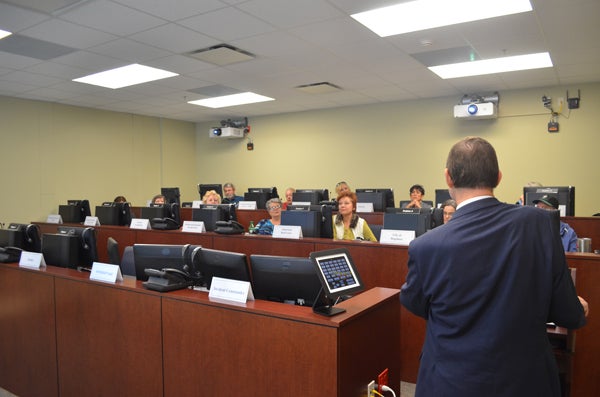Agencies slow to re-locate to 911 center
Published 4:49 am Wednesday, January 11, 2017

- DAILY NEWS PHOTO/Jesse Wright James Coleman, chairman of the Washington Parish Communications District, addresses the Washington Parish Republican Women on Tuesday.
On Tuesday, the Washington Parish Republican Women got a tour and an informational briefing about the Communications District building off Highway 10.
Specifically, the group wanted to know why the building — which was built in part to house the parish’s 911 operations and has a budget of nearly half-a-million dollars, still does not house the parish’s 911 operations.
Instead, the Franklinton Police Department, the sheriff and the Bogalusa Police Department each have separate 911 dispatch centers. While the Highway 10 building is ready to house the unified dispatches, there appears to be no immediate push to occupy the facility that includes more up-to-date communications equipment.
The bottom line seems to be that nobody wants to go first.
James Coleman, the chairman of the Washington Parish Communications District explained to the group that, first, the building has three functions with the 911 center being only one of those and, second, he suspects the reluctance to move to the central location is just a reluctance to change.
“We cannot force anyone to do it,” Coleman said, of the communications district.
Mike Haley, the sheriff’s chief deputy, said the issue is — in a word — complicated.
“This has been an ongoing issue and there are several facets to the issue,” Haley wrote, in an email. “It seems that before the facility was constructed, no plan was put in place to staff it with dispatchers from various parish agencies.
“It is a nice facility but we are not there for various reasons, including, one, it would be unwise to place a single dispatcher there with no support system. Two, we have no funds to relocate our dispatchers because to do so would require hiring additional personnel to man our lobby and handle walk-in complaints, jail visitation and other matters. Due to finances, we operated with staffing and do not have funds to create and staff additional positions.
“Three, if the other agencies relocated to the center it would be more feasible for us to relocate there, but even then we do not have funds to create and staff additional positions. The 911 Board does not compensate WPSO for handling 911 calls. I hope this bit of information is helpful.”
Franklinton’s police chief, Olander Smith, said he thinks the move would be smart as it’s a “state-of-the-art” facility. However, Smith said he didn’t think a small department like Franklinton’s should be the first to make the move. In addition, he said the decision would need to come from his bosses — Franklinton’s mayor and board of aldermen.
In Bogalusa, Mayor Wendy Perrette said she’s always supported the move, but in the past resistance has come from the police union. She said she considered it scandalous that the dispatch units have not yet consolidated.
Kendall Bullen, the city’s new police chief, said he had not yet given the move much thought yet. Bullen has been the chief since Jan. 1.
Coleman added that he believes the dispatchers themselves may also be opposed to the move because, as it is now, they can chat with officers in their down time, and they couldn’t do that if everything was consolidated.
“When things are slow, I have to assume they like to gossip and talk about this and that,” he said. “Out here they couldn’t face-to-face gossip with the officers. We think the social interaction will still be here, but at a different level.”
Besides housing the 911 dispatch, the communications building also houses the parish’s map development and addressing facilities, the facilities that mark locations on emergency maps to better serve service personnel. In addition, the building also has a centralized communications room in case of emergencies and can withstand high winds, bullets and explosions. The building’s total cost including antennas and equipment came to $3 million that was paid in federal and state grants.
Coleman said the building’s emergency notification system is so advanced that if dispatchers were to use it, they could alert residents in a specific location all at once via a recorded telephone message about an industrial or natural disaster.
On a day-to-day basis, 911 fees on telephone bills fund the building and Coleman estimated that, without the dispatch center, it’s being used to about two-thirds of its capacity. Coleman said the sheriff and the two police departments employ four people each to maintain each dispatch system 24 hours a day. If the three systems were to join, he said there would be no reduction in salaries, although everyone would move to the communications building.
“There would be no savings in cost,” he said. “They’d just move from one chair to another chair.”
However, Coleman said he believed the move could reduce distraction. As it is now, he said each department depends on its dispatchers to do all kinds of administrative tasks that have nothing to do with emergency dispatch. Removing them from the offices would mean they could focus only on dispatch and that could help save lives.
Coleman said the consolidation could also improve teamwork and communications between agencies.
Coleman said he believes one day the consolidation will happen.
“Once it starts, it’s going to snowball,” he said. “You just have to get one of them out here.”
Coleman said if citizens want a unified dispatch, they should gently “encourage” their leadership.
“Encouragement in a friendly manner,” he said. “Not in a confrontational manner.”





